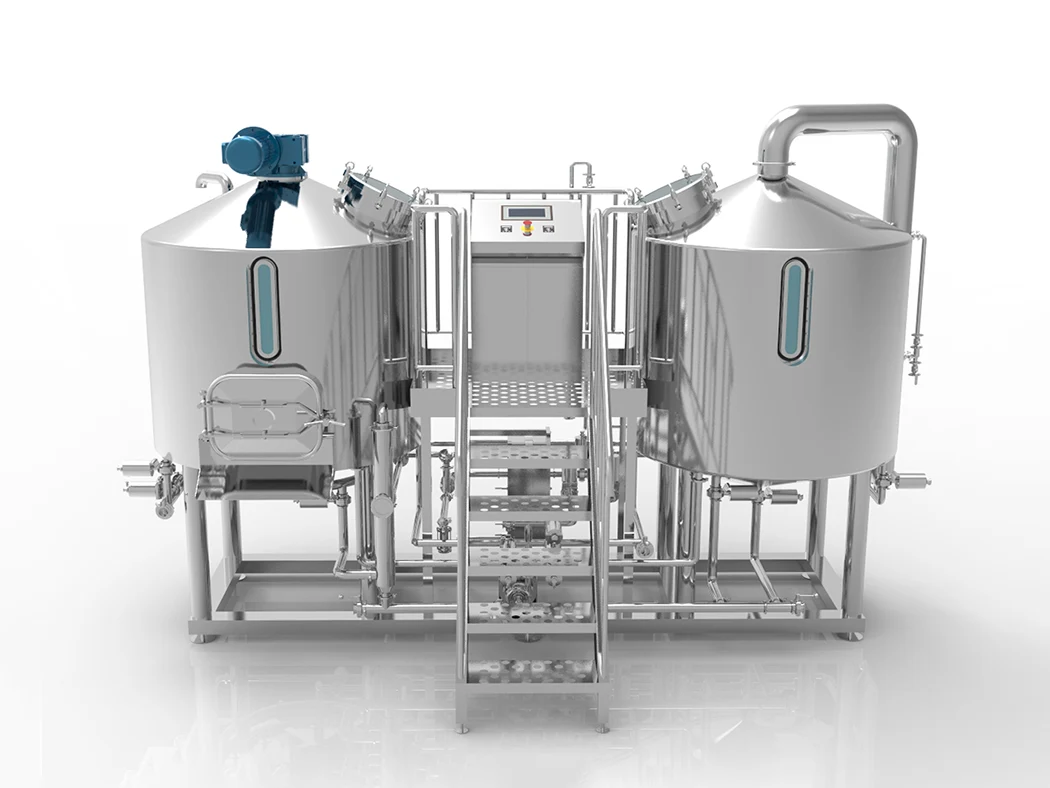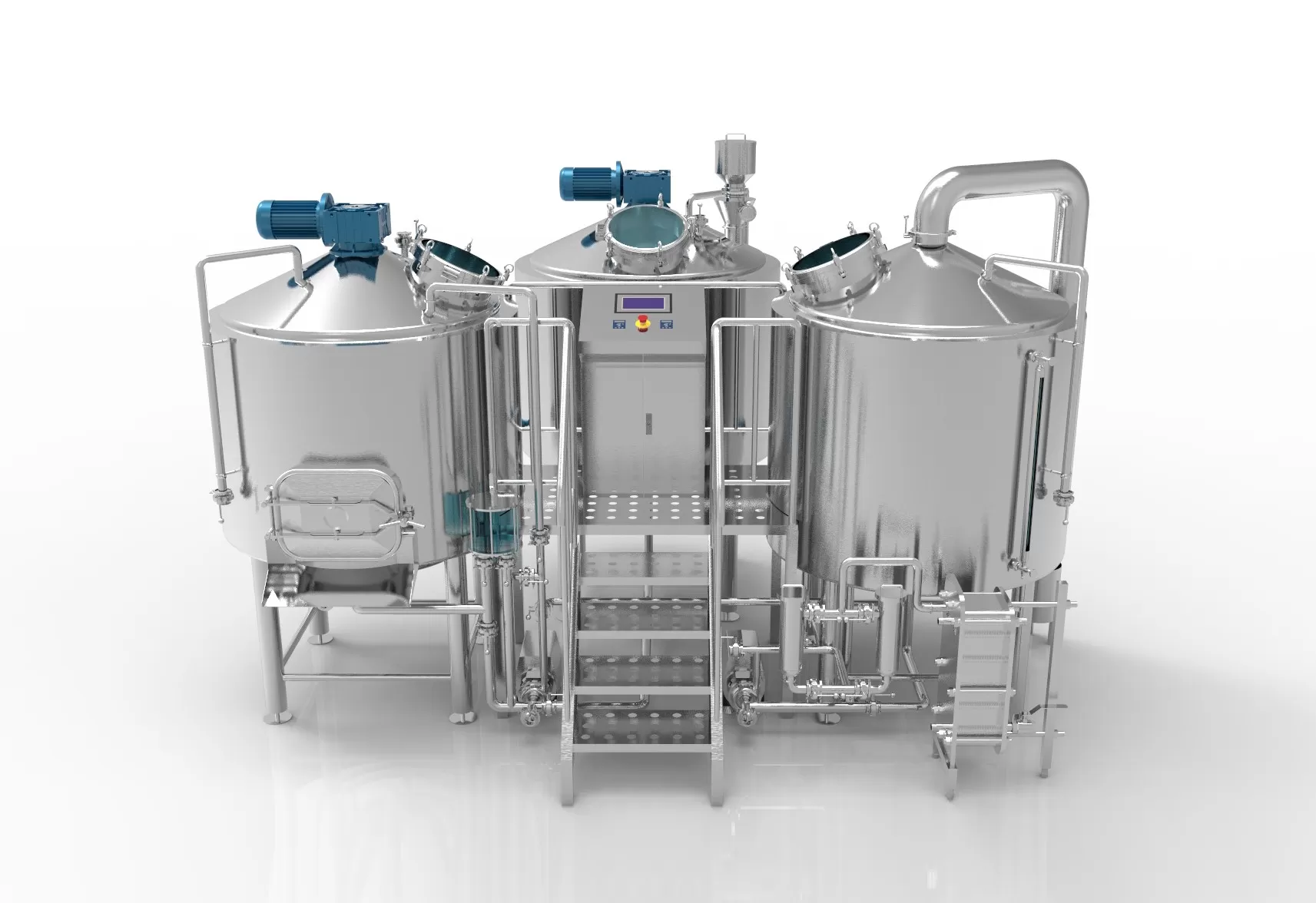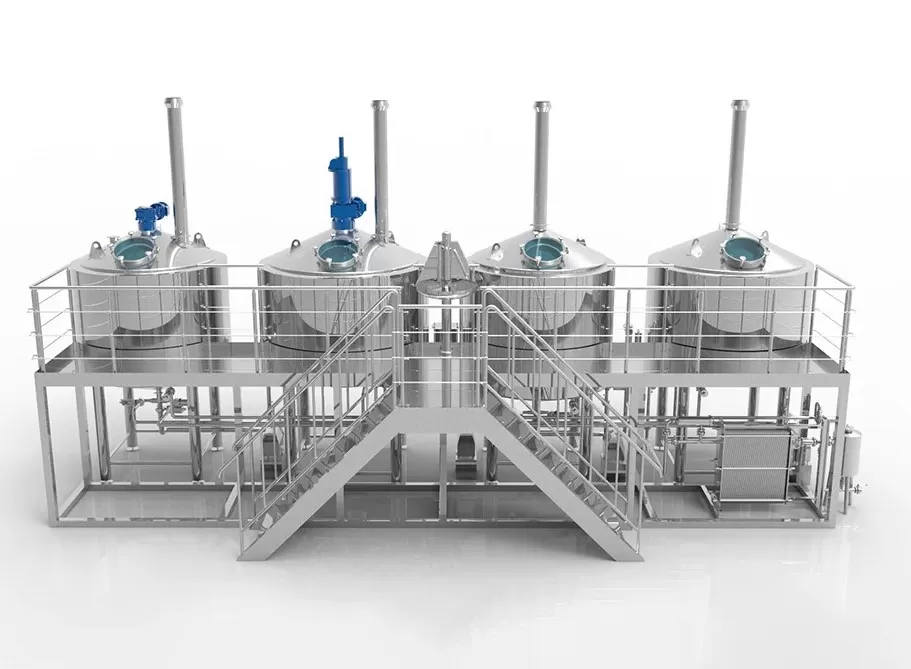Eine Brauerei zu gründen oder zu modernisieren ist eine große Herausforderung, oder? Die Wahl des falschen Bierbrauausrüstung führt zu kostspieligen Fehlern, schlechten Bier quality, and crippling inefficiency. Don’t let equipment choices stall your dream; this guide simplifies the Brauerei Einrichtungsprozess, der sicherstellt, dass Sie klug investieren, um erfolgreich zu sein.
Das Herzstück einer jeden Brauerei ist die Bierbrauanlage, die es ermöglicht, einfache Zutaten wie Malz, Wasser, Hopfen und Hefe in verschiedene Bierstile zu verwandeln. Zu den wichtigsten Komponenten gehören das Sudhaus (Maischebottich, Läuterbottich, Kessel, Whirlpool), Gärbehälter (Gärbottiche, Brittanks), Heiß-/Kaltlaugentanks, Pumpen, Kühler, eine Getreidemühle und Verpackungssysteme (Fass-, Dosen- oder Flaschenabfüllanlagen). Die Auswahl der richtigen Größe, Konfiguration und Qualität dieser Anlagen ist entscheidend für eine effiziente Produktion und die Herstellung von außergewöhnlichem Bier.
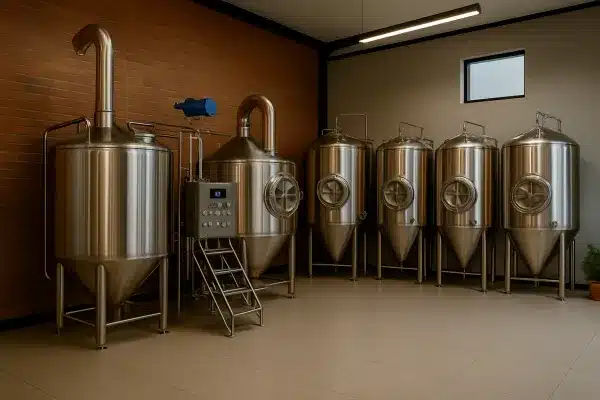
Aus welchen Hauptkomponenten besteht eine Bierbrauanlage?
Auf dem Weg zur Gründung einer Brauereiob es sich um ein kleines Start-up oder ein großes Unternehmen handelt, beginnt mit dem Verständnis der grundlegenden Teile der Ausrüstung und Zubehör. Stellen Sie sich das so vor, als würden Sie den Motor Ihres Hauses zusammenbauen. Bierherstellung Betrieb. Jede Komponente spielt eine entscheidende Rolle bei der Brauprozessvon der Verarbeitung des Rohgetreides bis zum fertig verpackten Produkt für Ihre Kunden. Ohne die richtige Einrichtung ist das Erreichen konsistenter, hochQualitätsbier wird zu einer großen Herausforderung.
In seinem Kern ist ein Brauerei braucht ein System zur Behandlung heißer Prozesse (die Sudhaus) und kalte Prozesse (Gärung und Konditionierung). Dies umfasst:
-
Getreideumschlag: A Getreidemühle zu knacken. Malz Körner, wodurch die Stärke zur Umwandlung freigegeben wird.
-
Sudhaus: Das Herzstück des Brauereiund umfasst in der Regel:
-
Maischebottich: Wo geschrotetes Getreide auf heißes Wasser trifft, um Stärke in vergärbaren Zucker umzuwandeln (Maische).
-
Läuterbottich: trennt die süße Flüssigkeit (Würze) aus den Getreidespelzen. Oft kombiniert mit dem Maischebottich.
-
Brühkessel: Wo die Würze wird gekocht, sterilisiert und Hopfen für Bitterkeit, Geschmack und Aroma hinzugefügt.
-
Whirlpool: Erzeugt einen Strudel, um Hopfenreste und Proteine (Trub) vom klaren Most zu trennen, Heißwürze vor dem Abkühlen.
-
-
Wärmetauscher: Kühlt schnell die Heißwürze auf die optimale Temperatur für Hefe Nicken.
-
Gärgefäße: Tanks aus rostfreiem Stahl (oft konische Fermenter) wobei Hefe konsumiert Zucker in der WürzeDabei entstehen Alkohol und CO2. Das ist der Punkt Bier wirklich gemacht ist.
-
Brite Tanks (Konditionierungstanks): Dient der Klärung, Reifung und Präzisierung von Karbonisierung Ebenen im Bier vor dem Verpacken.
-
Unterstützende Systeme: Pumpen, Schläuche, Ventile und Armaturen, Temperaturkontrollsysteme (Kältemaschinen), a CIP (Clean-In-Place)-System für die Abwasserentsorgung und möglicherweise Filtrationsanlagen.
-
Verpackungsausrüstung: Keg-Anlagen (Zapfpistolen, Waschmaschinen, Abfüller), Abfüllanlagen (FüllstoffVerschließer), oder Dosenlinien.
Wie erfahren Brauereiausrüstung manufacturers, we’ve seen countless variations, but these core elements form the backbone of nearly every successful Gebräu. Der Umfang, die Konfiguration (wie die Anzahl der Schiffe im Sudhaus) und der Automatisierungsgrad können sehr unterschiedlich sein, aber der grundlegende Prozess bleibt derselbe. Das Verständnis dieser Komponenten ist der erste Schritt zur Gestaltung Ausrüstung entworfen speziell für Ihre Bedürfnisse.
Wie funktioniert das Sudhaus bei der Bierherstellung?
Die Sudhaus ist der Ort, an dem die Magie des Bierbrauen process. It’s the “hot side” of the Brauereidie für die Bildung der zuckerhaltigen Flüssigkeit, die als Würzedie der Vorläufer von Bier. Betrachten Sie sie als die Küche, in der das Grundrezept Gestalt annimmt. Die Effizienz und das Design Ihrer Sudhaus direkte Auswirkungen Würze Qualität, Konsistenz zwischen den Chargen, Energieverbrauch und allgemeine Gebräu Tageslänge.
In der Regel beginnt der Prozess in der Maischebottich. Hier, präzise gefräst Malz wird mit heißem Wasser bei bestimmten Temperaturen gemischt. Diese Maische Der Prozess aktiviert Enzyme im Malz, die komplexe Stärke in einfachere Zucker umwandeln, die die Hefe können später während Gärung. Die Temperaturkontrolle ist hier absolut entscheidend. Nachdem die Maische ruht, die Flüssigkeit Würze muss vom Treber getrennt werden. Dies geschieht in der Läuterbottich (oder oft eine kombinierte Maische-/Läuterbottich). Heißes Wasser (Laugenwasser) wird sanft durch das Kornbett gespült, um so viel Zucker wie möglich zu extrahieren, was zu dem süßen Würze.
Diese Würze wird dann an den Braukessel. Dabei wird es kräftig gekocht, in der Regel 60-90 Minuten lang. Das Kochen dient mehreren wichtigen Zwecken: Es sterilisiert die WürzeDie Hopfenbittere wird durch die Isomerisierung der Hopfensäuren (Extraktion der Bitterkeit aus der Hopfenbittere) und durch den Entzug unerwünschter flüchtiger Verbindungen entfernt. Hopfen Zugaben) und kann zur Farb- und Geschmacksentwicklung beitragen. Hopfen wird in verschiedenen Phasen des Kochvorgangs zugegeben, um Bitterkeit, Geschmack und Aroma zu verleihen. Zum Schluss, vor dem Abkühlen, wird das kochende Würze wird oft durch einen Whirlpool geschickt Schiff oder Verfahren. Dabei wird die Zentrifugalkraft genutzt, um Hopfenpartikel und koagulierte Proteine (Trub) in einem sauberen Kegel in der Mitte des Behälters zu sammeln. Tankund ermöglicht eine klarere Würze für die Kühlung über den Wärmetauscher. Jeder Schritt im Sudhaus ist von entscheidender Bedeutung für die Gestaltung des Fundaments Ihrer Qualitätsbier.
Warum sind Gärbehälter für Ihre Brauerei so wichtig?
Wenn die Sudhaus ist die Küche, dann ist die Gärbehälter are where the raw ingredients transform into the final product. This is the “cold side” where the cooled Würze trifft Hefeund die aktuelle Gärung auftritt. Die Qualität, das Design und die Sauberkeit Ihrer Fermenter Und Brittanks sind von entscheidender Bedeutung für die Herstellung sauberer, konsistenter und hochwertiger Bier. Man darf die Bedeutung dieser Phase nicht unterschätzen.
Die häufigste Art von Fermenter in modernen Handwerksbrauereien ist die zylindrokonische Tank (oft einfach als konischer Fermenter). Diese vielseitigen Edelstahlbehälter sind in der Regel ummantelt für präzise Temperaturkontrollewas entscheidend ist, da Hefe Aktivität erzeugt Wärme. Der konische Boden ermöglicht das einfache Auffangen und Entfernen von Hefe und Trub nach Gärung. Primäre Gärung dauert in der Regel ein bis zwei Wochen, je nach Art der Bier Stil und Hefestamm. Während dieser Zeit wandelt die Hefe Zucker in Alkohol und CO2 um, wodurch die charakteristischen Merkmale des Produkts entstehen. Bier. Richtig Temperaturkontrolle sorgt für eine optimale Leistung der Hefe und verhindert die Bildung von Fehlaromen.
Nach der primären Gärung, the “green” Bier wird häufig auf eine Brittank (oder Konditionierung Tank) oder in derselben Weise konditioniert Fermenter. Die Brittank ist ein druckbeständiges Schiff für die Klärung des Bier (damit sich Hefereste und Partikel absetzen können), die Reifung der Aromen und das Erreichen des gewünschten Grads an Karbonisierung. Karbonisierung kann auf natürliche Weise durch Auffangen des am Ende der Gärung entstehenden CO2 (Spunding) oder durch Zwangskarbonisierung mit externem CO2 erfolgen. Von der Brittankdie Bier ist endlich bereit für die Verpackung in Fässer, Flaschen oder Dosen. Als Hersteller von hochwertigen Edelstahl-Gärtanks & Bright Tanks, we emphasize the importance of sanitary design, robust construction (often using 304 Edelstahl), and reliable Temperaturkontrolle in these critical beer tanks.
Was sollten Sie bei der Auswahl einer Getreidemühle beachten?
Often overlooked by newcomers, the Getreidemühle is a foundational piece of Brauereiausrüstung. While seemingly simple, its performance directly impacts your brewhouse efficiency and the consistency of your Maische. Choosing the right mill ensures you get the most sugar extraction from your Malz without causing problems down the line. An improper crush can lead to a stuck sparge (where wort flow stops during lautering) or lower-than-expected sugar yield, affecting your final beer’s alcohol content and body.
The primary function of a Getreidemühle is to crack the outer husk of the Malz kernels while crushing the internal starches (endosperm). You want the husks to remain relatively intact, as they form a natural filter bed during the lauter process. However, the endosperm needs to be sufficiently broken up to allow hot water access for starch conversion during the Maische. Most brewery mills use adjustable rollers (typically two or four rollers) to achieve this. The gap between the rollers determines the fineness of the crush. Finding the optimal crush setting often requires a bit of experimentation based on your specific Sudhaus setup (especially your Läuterbottich design) and the type of Malz being used.
Key considerations when selecting a Getreidemühle include:
-
Throughput: Kann die mill process enough grain quickly enough for your batch size and brew schedule? Look at ratings in kg or lbs per hour.
-
Roller Adjustability: Fine control over the roller gap is essential for dialing in the perfect crush for all-grain brewing.
-
Number of Rollers: Four-roller mills generally offer a more consistent crush with better husk preservation compared to two-roller mills, but come at a higher cost.
-
Material: Durable materials like hardened steel for the rollers ensure longevity.
-
Dust Control: Milling creates dust; consider options for dust mitigation or collection.
-
Integration: Will the mill feed directly into a grist case or auger system connected to your Maischebottich?
Investing in a quality Getreidemühle pays dividends in efficiency and consistency for every Gebräu. It’s a critical first step in the Bierherstellung Prozess.
Welchen Einfluss haben Pumpen, Ventile und Armaturen auf Ihren Brauprozess?
While the big shiny Tanks often get the most attention, the network of Pumpen, valvesund Beschläge forms the circulatory system of your Brauerei. These components are responsible for moving liquids – water, Maische, Würzeund Bier – between different Schiffe safely and efficiently. The quality, type, and layout of this plumbing directly impact sanitation, flow control, process efficiency, and operator safety. Choosing the wrong components can lead to leaks, contamination risks, flow restrictions, and difficult cleaning processes.
Pumpen are essential for transferring liquids, especially in larger systems where gravity feeding isn’t practical. Brewery pumps need to be sanitary (easily cleanable), robust enough to handle varying temperatures and viscosities (like thick Maische oder Heißwürze), and ideally designed to minimize shearing forces that could damage delicate compounds. Centrifugal pumps are common, often paired with Variable Frequency Drives (VFDs) to allow precise flow control. Ventile, such as butterfly valves or ball valves, control the start, stop, and direction of flow through pipes and hoses. They must be sanitary, easy to operate, and made from durable materials like 304 Edelstahl to withstand cleaning chemicals and temperature fluctuations. Look for valves that minimize dead space where microbes could hide.
Fittings (like tri-clamp fittings, commonly used in breweries for their sanitary design and ease of assembly/disassembly) connect pipes, hoses, valves, and equipment. Using standardized, high-quality Beschläge ensures leak-proof connections and simplifies maintenance and cleaning. Every connection point, every Ventil, every meter of pipe oder hose needs to be considered part of the overall system design. As providers of Brauerei-Teile, we understand that reliable Ventile und Armaturen are crucial for smooth operation and maintaining the integrity of your Bier throughout the entire Brauprozess.
Welche Rolle spielen CIP-Systeme bei der Aufrechterhaltung der Brauereihygiene?
Cleanliness isn’t just next to godliness in a Brauerei; it is godliness. Maintaining impeccable hygiene is non-negotiable for producing stable, high-Qualitätsbier free from spoilage organisms and off-flavours. This is where a Clean-In-Place (CIP) system becomes indispensable, especially in commercial brauereien. A CIP system allows for the effective cleaning and sanitizing of Tanks, pipes, and other Brauereiausrüstung without requiring disassembly, saving significant time and labour while ensuring thorough results.
A typical CIP system consists of Tanks for holding cleaning and sanitizing solutions, a Pumpe to circulate these solutions, and associated valves, hoses, and often a Wärmetauscher to control solution temperature. The process usually involves several cycles:
-
Pre-Rinse: Flushing with water to remove loose soil and debris.
-
Ätzende Wäsche: Circulating a hot alkaline detergent solution (like caustic soda) to break down organic soils (proteins, hop resins, yeast).
-
Zwischenzeitliche Spülung: Flushing with water to remove the caustic solution.
-
Acid Wash (Optional but Recommended): Circulating an acid solution to remove mineral deposits (beerstone) and neutralize any remaining caustic.
-
Letzte Spülung: Flushing thoroughly with water.
-
Sanitize: Circulating a sanitizing solution (like peracetic acid – PAA) just before the Ausrüstung is needed for the next Gebräu oder Bier transfer, killing any remaining microorganisms.
Effective CIP relies on the “TACT” principles: Time, Action (flow rate/turbulence), Chemical concentration, and Temperature. Your CIP system needs to be designed to deliver the correct parameters for each piece of Ausrüstung being cleaned. Investing in a well-designed CIP system is investing in Bier quality, consistency, and brand reputation. It ensures that every Charge starts with a clean slate, allowing the desired flavours of your Malz, hops, and Hefe to shine through without interference from unwanted microbes. Trying to make beer commercially without a proper CIP process is fighting an uphill battle you are unlikely to win.
Erkundung verschiedener Sudhauskonfigurationen: 2-Gefäß vs. 3-Gefäß vs. 4-Gefäß?
Bei der Auswahl von Brauereiausrüstung, one of the most significant decisions revolves around the configuration of the Sudhaus. The number of main Schiffe (typically referring to the Maischebottich, Läuterbottich, Braukessel, and whirlpool) dictates the workflow, potential throughput, flexibility, and initial cost. The most common configurations are 2-Vessel, 3-Vessel, and 4-Vessel systems.
-
2-Vessel Brewhouse: This is the most common setup for smaller microbreweries and brewpubs. It typically combines the Maischebottich Und Läuterbottich into one Schiff (Mash/Lauter Tun or MLT) and the Braukessel and whirlpool into a second Schiff (Kettle/Whirlpool Tun or KWT).
-
Vorteile: Lower initial cost, smaller footprint. Simple to operate.
-
Nachteile: Less efficient use of time, as you cannot start mashing the next Gebräu until the Wasserkocher is empty from the previous one. Limits throughput (typically one Charge per Gebräu day unless very long days are worked). Our 10BBL 2-Gefäß-Mikrobrauereiausrüstung is a popular example.
-
-
3-Vessel Brewhouse: This configuration typically separates the Maischebottich, Läuterbottichund brew kettle/whirlpool into distinct Schiffe. Sometimes the whirlpool is also a separate Schiff.
-
Vorteile: Increased efficiency and throughput. Allows for starting the Maische of the next Charge while the previous Charge is boiling in the Wasserkocher. Offers more flexibility in mashing techniques.
-
Nachteile: Higher cost and larger footprint than a 2-vessel system. More complex plumbing and control. Ideal for growing breweries, like our 1500L 3 Gefäße Brauereianlage.
-
-
4-Vessel Brewhouse: This setup features dedicated Schiffe for each primary hot-side process: Maischebottich, Läuterbottich, Brühkessel, and Whirlpool Tank.
-
Vorteile: Maximum efficiency and throughput, allowing for multiple brews per day (back-to-back Brauen). Offers the greatest flexibility and control over each step. Standard for larger production brauereien.
-
Nachteile: Highest initial cost, largest footprint, greatest complexity in operation and automation. See our 20HL 4 Gefäße Gewerbliche Brauereianlagen for an example of a robust commercial system.
-
Choosing the right configuration depends heavily on your production goals, budget, available space, and desired operational workflow. As manufacturers, we design and build all configurations, tailoring the Sudhäuser to meet the specific needs of each Brauerei.
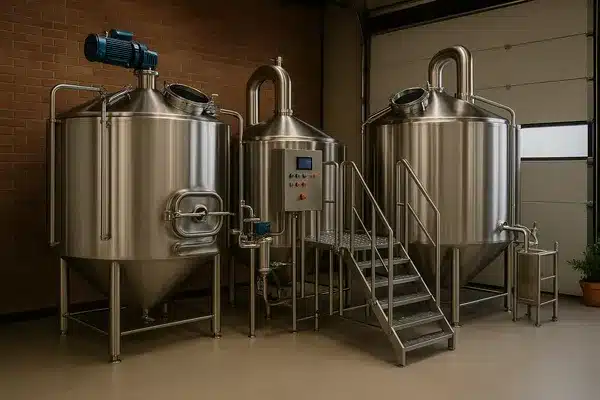
Kegs, Flaschen oder Dosen: Wie wählen Sie Ihre Bierverpackungs-Abfüllanlage?
Once your Bier is perfectly fermented, conditioned, and carbonated in a Brittank, the final step before it reaches the consumer is packaging. The choice between Fässer, bottles, and cans significantly impacts your distribution strategy, market reach, branding, and the type of packaging equipment you’ll need. Each format has its pros and cons, and many brauereien utilize a combination.
-
Fässer: The traditional format for draft Bier served in pubs, bars, and restaurants, as well as for direct sales from the Brauerei taproom. Kegging generally requires the lowest initial investment in packaging equipment (keg washers and fillers).
-
Vorteile: Relatively low cost per volume, excellent protection against light and oxygen, reusable (Fässer can last for decades), preferred format for on-premise consumption. Requires Zapfpistolen at the point of dispense.
-
Nachteile: Limited reach (primarily draft accounts), requires a cold chain for distribution and storage, consumers need specialized equipment (kegerator) for home brew enjoyment.
-
-
Bottles: A classic packaging choice offering good shelf stability and a premium perception for certain Bier styles. Bottling lines range from simple manual fillers and Kappen tools to fully automated systems.
-
Vorteile: Wide consumer acceptance, good shelf life (especially dark glass), allows for bottle conditioning, perceived quality image. Requires bottle caps.
-
Nachteile: Heavier and bulkier than cans (higher shipping costs), susceptible to light damage (especially clear or green glass), risk of breakage, higher oxygen pickup potential during filling compared to modern canning. Slower filling speeds compared to canning on automated lines.
-
-
Cans: Increasingly popular in the Craft-Bier world due to their portability, sustainability, and superior protection against light and oxygen. Canning lines are typically more complex and expensive than basic kegging or bottling setups.
-
Vorteile: Complete protection from light, near-zero oxygen pickup with good Füllstoff technology, lighter weight (lower shipping costs), highly recyclable, stackable, portable, appeals to modern consumers.
-
Nachteile: Higher initial investment in canning line, potential for negative consumer perception (though this is fading fast), requires careful seam inspection to ensure integrity.
-
Your choice will depend on your target market, production volume, budget, and brand strategy. Investing in reliable Verpackungsausrüstung is crucial to ensure your carefully crafted Bier reaches the drinker in the best possible condition, whether it’s perfectly carbonated in a fass, securely sealed in a bottle, or protected from the elements in a kann.
Mehr als nur die Grundlagen: Unverzichtbare Brauerei-Zusatzausrüstung?
While the Sudhaus Und Gärbehälter are the stars, a supporting cast of ancillary Ausrüstung is essential for a functioning and efficient Brauerei. These systems might not be involved directly in mashing or fermenting, but they provide critical utilities like heating, cooling, cleaning, and analysis that enable the core processes to run smoothly and effectively. Neglecting these can create bottlenecks, compromise quality, and increase operating costs.
Key ancillary systems include:
-
Hot Liquor Tank (HLT): Stores and heats the water used for mashing and sparging. Having a dedicated HLT allows for faster Gebräu days as large volumes of water can be pre-heated.
-
Cold Liquor Tank (CLT): Stores cold water, often chilled water, used primarily for rapidly cooling the Würze through the Wärmetauscher. Crucial for consistent Gärung temperatures and efficient Kühler operation.
-
Chiller / Glycol System: Provides the cooling capacity needed for crashing Würze temperatures post-boil (via the Wärmetauscher) and maintaining precise Gärtemperaturregelung in jacketed Fermenter Und Brittanks. Usually involves circulating a chilled food-grade propylene glycol/water mixture.
-
Boiler or Steam Generator: Provides steam for heating the Braukessel and HLT in larger systems (steam heating is generally more efficient and responsive than direct fire or electric brewing elements for large volumes).
-
Pumps, Hoses, and Piping: As discussed earlier, essential for moving liquids. Includes sanitary hoses, hard pipe installations, and reliable transfer Pumpen. Ensure you have the right hose types for different temperature and pressure requirements.
-
Control Panel / Automation: From basic temperature controllers to fully automatisierte Brühsysteme, controls manage temperatures, Pumpe operations, valve actuation, and process timing, ensuring consistency and repeatability.
-
Lab Equipment: Essential for quality control. Includes tools like a hydrometer (or refractometer) for measuring sugar content (Würze gravity), pH meter, thermometer, microscope (for yeast health checks), and potentially dissolved oxygen meters. Helps the brauer make informed decisions and track Bier consistency.
These supporting systems work together to create a cohesive and efficient Bierbrauen operation. When planning your equipment for your brewery, remember to budget and allocate space for these vital ancillary components. They are fundamental to producing Qualitätsbier consistently and efficiently.
Wie kann die Micet-Gruppe Ihnen bei der Auswahl der richtigen Brauereiausrüstung helfen?
Navigating the complex world of Brauereiausrüstung can be daunting, especially with so many options and configurations available. That’s where we, Micet Group, come in. As experienced manufacturers of high-quality, customizable Brauereiausrüstung, we partner with breweries of all sizes – from startup home brewers scaling up, to brewpubs, Handwerksbrauereien, and large Großbrauerei operations – to design and build systems tailored to their specific needs and goals. We understand the challenges you face because Brauen is in our DNA.
Our approach is built on collaboration and expertise. We don’t just sell Tanks; we provide complete solutions. This starts with understanding your vision: What kind of Bier do you want to Gebräu? What’s your target production volume? What’s your budget and available space? Based on this, our engineers can help you configure the ideal system, whether it’s a compact 1000L Small Batch Brewing System or a multi-Schiff Großbrauerei setup. We specialize in high-grade rostfreier Stahl fabrication (304 or higher), ensuring durability, longevity, and ease of sanitation for all our Ausrüstung entworfen for brewing.
We offer a comprehensive range of Ausrüstung und Zubehör, including various Sudhaus configurations, Gärbehälter (konische Fermenter, Brittanks), Hefe propagation Tanks, CIP systems, fass washers/fillers, and ancillary components like Pumpen, Kältemaschinenund control panels. Our commitment extends beyond manufacturing; we provide installation support, training, and ongoing technical assistance to ensure your Brauerei operates smoothly and efficiently. We aim to be more than just a supplier; we strive to be a trusted partner in your Brauen success story. Let us help you turn your Bierbrauen dreams into reality with reliable, efficient, and customizable Brauereiausrüstung.
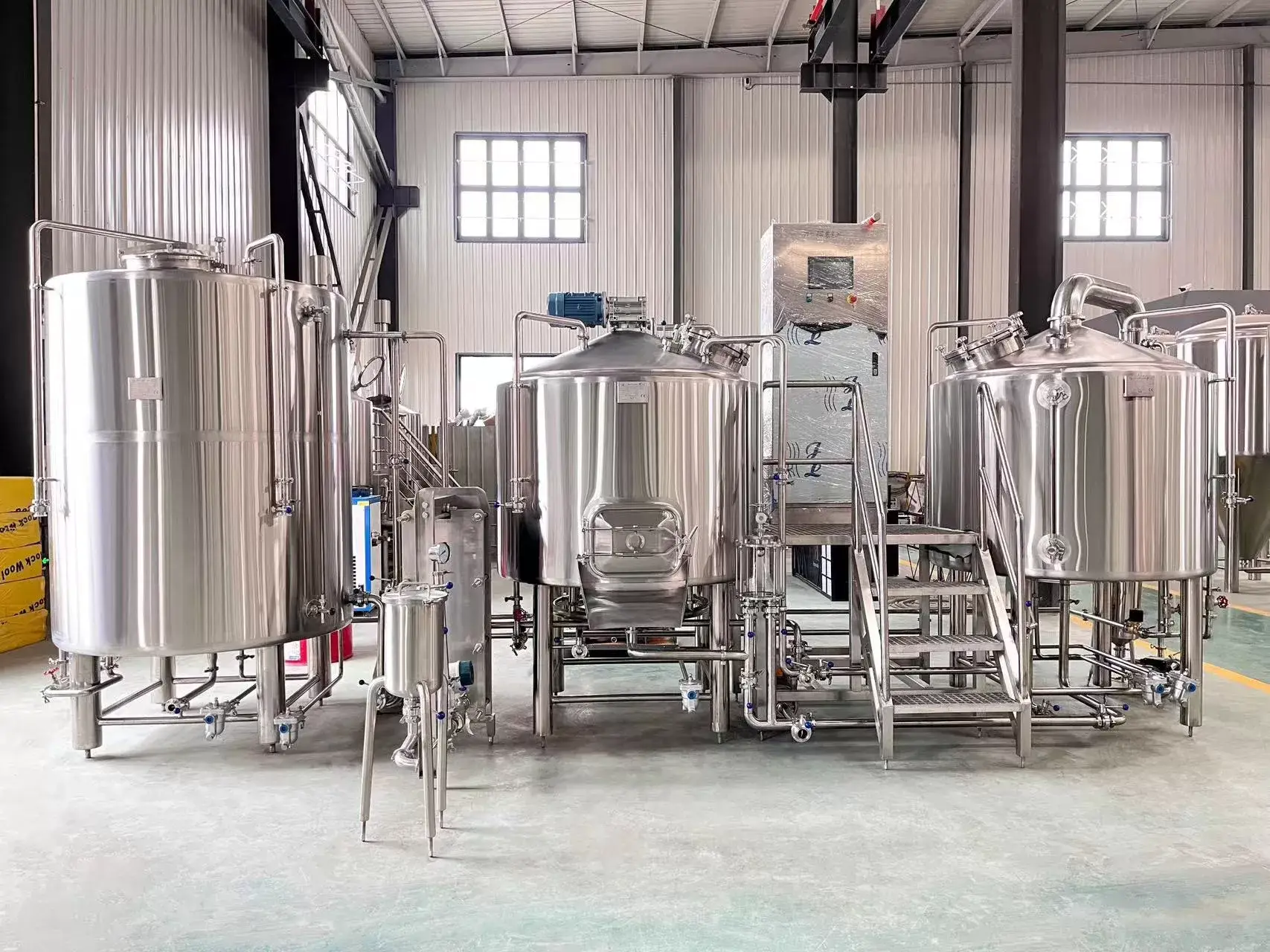
FAQs
What is the difference between a mash tun and a lauter tun?
A Maischebottich is the Schiff where crushed Malz and hot water are mixed to convert starches into fermentable sugars (the Maische). A Läuterbottich is designed specifically to separate the sweet liquid Würze from the solid grain husks after mashing. In many smaller Sudhäuser (like 2-vessel systems), these two functions are combined into a single Schiff called a Mash/Lauter Tun (MLT). Larger, higher-efficiency systems often use separate Schiffe for optimized performance of each step.
How long does beer need to stay in a fermenter?
The time Bier spends in a Fermenter varies significantly depending on the Bier style, yeast strain, and Gärung temperature. Primary Gärung, where most of the alcohol is produced, typically takes 1-2 weeks for ales and potentially longer (3-6 weeks or more) for lagers fermented at cooler temperatures. After primary Gärungdie Bier might be conditioned or matured for additional days, weeks, or even months, either in the same Fermenter or transferred to a separate conditioning Tank oder Brittank.
What does CIP stand for and why is it important in a brewery?
CIP stands for Clean-In-Place. It’s a method for cleaning the interior surfaces of pipes, Schiffe, Tanksund Beschläge without disassembling the equipment. A CIP system circulates cleaning and sanitizing solutions throughout the Brauereiausrüstung. It’s critically important because Bier is susceptible to spoilage by bacteria and wild yeast. Regular and effective CIP ensures that equipment is hygienically clean, preventing contamination and ensuring the production of consistent, high-Qualitätsbier. It also saves significant time and labor compared to manual cleaning.
What basic equipment do I need to start homebrewing beer?
To start Heimbrauen simple extract-based beer at home, you typically need a basic brewing kit. This usually includes a large pot (Wasserkocher) for boiling the Würze, a Fermenter (often a food-grade bucket or carboy with an airlock), tubing for transferring (siphoning), a sanitizer, cleaner, and bottling equipment (bottles, bottle caps, a capper) or a small kegging setup. You’ll also need measuring tools like a thermometer and potentially a hydrometer to measure sugar levels. Many beginners start with all-in-one electric Brauanlagen that combine the Wasserkocher Und Maische functions for easier all-grain brewing.
Can I use the same tanks for brewing beer and kombucha?
While both involve Gärung, it’s generally strongly recommended not to use the same Gärbehälter für Bier and kombucha interchangeably without extremely rigorous cleaning and sanitation protocols. Kombucha fermentation relies on a symbiotic culture of bacteria and yeast (SCOBY), which includes microorganisms like Acetobacter that can cause souring and undesirable flavours in Bier. Even trace amounts surviving cleaning could potentially infect subsequent Bier batches. Dedicated Kombucha-Fermentierungstanks are the safest approach to prevent cross-contamination.
How is beer carbonated in a commercial brewery?
Kommerziell brauereien typically carbonate their Bier in Brittanks (conditioning Tanks) after Gärung and clarification. This is usually done through “force carbonation,” where CO2 gas is bubbled through a porous “stone” submerged in the Bier within the pressurized Tank until the desired dissolved CO2 level is reached. Alternatively, some brauereien use “spunding,” where the Fermenter is sealed towards the end of Gärung to naturally trap the CO2 produced by the Hefe. Precise temperature and pressure control are essential for achieving consistent Karbonisierung.
Key Takeaways for Selecting Beer Brewing Equipment:
-
Core Components: Understand the function of each key piece: Getreidemühle, Sudhaus (Maischebottich, Läuterbottich, Wasserkocher, whirlpool), Wärmetauscher, Fermenter, Brittanks.
-
Brewhouse Configuration: Choose the right number of Schiffe (2, 3, or 4) based on your production goals, space, budget, and desired workflow efficiency.
-
Fermentation is Key: Invest in quality stainless steel fermentation vessels with reliable Temperaturkontrolle and sanitary design for consistent, high-Qualitätsbier.
-
Don’t Forget Ancillaries: Systems like Kältemaschinen, boilers, Pumpen, valves, Beschlägeund CIP are crucial for efficient and hygienic operation.
-
Packaging Matters: Select kegging, bottling, or canning Ausrüstung based on your target market, distribution strategy, and budget.
-
Cleanliness is Crucial: Implement rigorous cleaning and sanitation protocols, ideally utilizing an effective CIP System.
-
Customization & Support: Partner with an experienced manufacturer like Micet Group who can provide customizable solutions and ongoing technical support for your Brauereiausrüstung.

